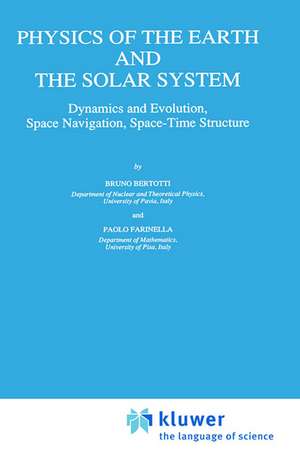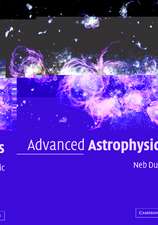Physics of the Earth and the Solar System: Dynamics and Evolution, Space Navigation, Space-Time Structure: Geophysics and Astrophysics Monographs, cartea 31
Autor B. Bertotti, Paolo Farinellaen Limba Engleză Hardback – 30 apr 1990
".....The book is a very good balance between theory and applications, of analysis and synthesis, keeping always the focus on the comprehension of the physics ruling our planetary system.
In summary, this represents both an excellent textbook for students and a fundamental reference, and encyclopedic summary current knowledge, for researchers in the Solar System field." (Alessandro Rossi, Celestial Mechanics and Dynamical Astronomy, 2005)
| Toate formatele și edițiile | Preț | Express |
|---|---|---|
| Paperback (1) | 1226.42 lei 6-8 săpt. | |
| SPRINGER NETHERLANDS – 14 dec 2011 | 1226.42 lei 6-8 săpt. | |
| Hardback (1) | 1232.57 lei 6-8 săpt. | |
| SPRINGER NETHERLANDS – 30 apr 1990 | 1232.57 lei 6-8 săpt. |
Din seria Geophysics and Astrophysics Monographs
- 15%
 Preț: 646.43 lei
Preț: 646.43 lei - 24%
 Preț: 1032.02 lei
Preț: 1032.02 lei -
 Preț: 382.75 lei
Preț: 382.75 lei - 18%
 Preț: 950.33 lei
Preț: 950.33 lei - 15%
 Preț: 642.36 lei
Preț: 642.36 lei - 15%
 Preț: 641.53 lei
Preț: 641.53 lei - 18%
 Preț: 953.35 lei
Preț: 953.35 lei -
 Preț: 403.91 lei
Preț: 403.91 lei - 15%
 Preț: 641.71 lei
Preț: 641.71 lei -
 Preț: 402.17 lei
Preț: 402.17 lei - 15%
 Preț: 641.85 lei
Preț: 641.85 lei - 18%
 Preț: 1222.01 lei
Preț: 1222.01 lei - 18%
 Preț: 1825.44 lei
Preț: 1825.44 lei - 18%
 Preț: 2098.19 lei
Preț: 2098.19 lei - 18%
 Preț: 947.85 lei
Preț: 947.85 lei - 24%
 Preț: 794.98 lei
Preț: 794.98 lei - 18%
 Preț: 1227.52 lei
Preț: 1227.52 lei - 15%
 Preț: 641.03 lei
Preț: 641.03 lei -
 Preț: 384.48 lei
Preț: 384.48 lei - 15%
 Preț: 697.15 lei
Preț: 697.15 lei - 18%
 Preț: 2089.50 lei
Preț: 2089.50 lei -
 Preț: 390.63 lei
Preț: 390.63 lei - 18%
 Preț: 943.73 lei
Preț: 943.73 lei - 18%
 Preț: 950.66 lei
Preț: 950.66 lei -
 Preț: 386.61 lei
Preț: 386.61 lei -
 Preț: 395.25 lei
Preț: 395.25 lei - 18%
 Preț: 951.91 lei
Preț: 951.91 lei
Preț: 1232.57 lei
Preț vechi: 1503.14 lei
-18% Nou
Puncte Express: 1849
Preț estimativ în valută:
235.88€ • 245.35$ • 194.73£
235.88€ • 245.35$ • 194.73£
Carte tipărită la comandă
Livrare economică 14-28 aprilie
Preluare comenzi: 021 569.72.76
Specificații
ISBN-13: 9780792305354
ISBN-10: 0792305353
Pagini: 480
Ilustrații: XVI, 480 p.
Dimensiuni: 156 x 234 x 27 mm
Greutate: 0.87 kg
Ediția:1990
Editura: SPRINGER NETHERLANDS
Colecția Springer
Seria Geophysics and Astrophysics Monographs
Locul publicării:Dordrecht, Netherlands
ISBN-10: 0792305353
Pagini: 480
Ilustrații: XVI, 480 p.
Dimensiuni: 156 x 234 x 27 mm
Greutate: 0.87 kg
Ediția:1990
Editura: SPRINGER NETHERLANDS
Colecția Springer
Seria Geophysics and Astrophysics Monographs
Locul publicării:Dordrecht, Netherlands
Public țintă
ResearchCuprins
1. Dynamical Principles.- 1.1. Gravitational equilibrium.- 1.2. Dynamical equations.- 1.3. Dynamics of solid bodies.- 1.4. Transport.- 1.5. Magnetohydrodynamics.- 1.6. Conservation of magnetism and vorticity.- 1.7. Kinetic theory.- Problems.- 2. The Gravitational Field of a Planet.- 2.1. Spherical harmonics.- 2.2. Harmonic representation of the gravity field of a planet.- 2.3. Low order gravitational potential.- 2.4. Fine structure of the gravity field of the earth.- Problems.- 3. The Rotation of the earth and other Planets.- 3.1. Measurements of time and distance.- 3.2. Rotating frames.- 3.3. Slow rotation of a fluid body.- 3.4*. Equilibrium shapes of bodies in rapid rotation.- 3.5. Rigid body dynamics: free precession.- 3.6*. The rotation of the earth and its interior structure.- Problems.- 4. Tidal Effects.- 4.1. Lunisolar precession and nutation.- 4.2. Tidal potential.- 4.3. Tides in a non-rigid earth.- 4.4. Tidal harmonics.- 4.5*. Equilibrium shapes of satellites.- Problems.- 5. The Interior of the Earth.- 5.1. Seismic propagation.- 5.2*. Boundary effects.- 5.3. Internal structure of the earth.- 5.4. Heat generation and flow.- 5.5. Tectonic motions.- Problems.- 6. Planetary Magnetism.- 6.1. The main dipole field.- 6.2. Magnetic harmonics and anomalies.- 6.3. Secular changes and reversals.- 6.4*. The generation of planetary magnetic fields.- Problems.- 7. Atmospheres.- 7.1. The structure of the atmosphere.- 7.2*. Radiative transfer.- 7.3*. Gray atmospheres.- 7.4. Dynamics of the atmosphere and the oceans.- 7.5. Tropospheric turbulence.- Problems.- 8. The Upper Atmosphere.- 8.1. Ionizing effects of the solar radiation.- 8.2. Propagation of electromagnetic waves in an electron plasma.- 8.3. Electromagnetic propagation in the ionosphere.- 8.4. Structure and mass motion.- Problems.- 9. Magnetosphere.- 9.1. The guiding centre approximation.- 9.2. Trapped particles.- 9.3. Alfvén waves.- 9.4. The bow shock of the magnetosphere.- 9.5. Interaction between the solar wind and the magnetosphere.- 9.6*. Energetic particles in the magnetosphere.- Problems.- 10. The Two-Body Problem.- 10.1. Reduction to a central force problem.- 10.2. Keplerian orbits.- 10.3. Three-dimensional orbital elements.- 10.4. Unbound orbits.- Problems.- 11. Perturbation Theory.- 11.1. Gauss’ perturbation equations.- 11.2. Qualitative discussion of some perturbations.- 11.3. Effects of atmospheric drag.- 11.4. The perturbing function and Lagrange’s perturbation equations.- 11.5. Approximate solution methods.- 11.6. Secular effects of the oblateness of the primary.- Problems.- 12. The Restricted Three-Body Problem.- 12.1. Equations of motion and the Jacobi constant.- 12.2. Lagrangian points and zero-velocity curves.- 12.3. Stability of the Lagrangian points.- 12.4*. Tisserand’s invariant.- Problems.- 13. The Sun and the Solar Wind.- 13.1. The sun and its radiation.- 13.2. Mathematical theory of the solar wind.- 13.3. Structure of the corona and the solar wind.- 13.4. Planetary magnetospheres.- Problems.- 14. The Planetary System.- 14.1. Planets.- 14.2. Satellites.- 14.3. Asteroids.- 14.4. Comets.- 14.5. Interplanetary material and meteorites.- 14.6. Planetary rings and the Roche limit.- 14.7*. From boulders to planets.- Problems.- 15. Dynamical Evolution of the Solar System.- 15.1. Secular perturbations and the stability of the solar system.- 15.2*. Resonances and chaotic behavior.- 15.3. Tidal evolution of orbits.- 15.4. Dynamics of dust particles.- Problems.- 16. Origin of the Solar System.- 16.1. Mass and structure of the solar nebula.- 16.2. Growth and settlingof solid grains.- 16.3. Gravitational instability and formation of planetesimals.- 16.4. Collisional accumulation of planetesimals.- 16.5. Accretion.- 16.6. Formation of giant planets and minor bodies.- Problems.- 17. Relativistic Effects in the Solar System.- 17.1. Curvature of spacetime.- 17.2. Geodesics.- 17.3. Dynamics as geometry.- 17.4. Slow motion, relativistic dynamics.- 17.5. The Doppler effect.- 17.6. Relativistic dynamical effects.- 17.7*. Gravitomagnetism.- Problems.- 18. Artificial Satellites.- 18.1. Perturbations.- 18.2. Launch.- 18.3. Spacecraft.- 18.4. Geostationary satellites.- 18.5. Interplanetary navigation.- Problems.- 19. Space Telecommunications.- 19.1. The power budget.- 19.2. Spectra.- 19.3. Noise.- 19.4. Phase measurements.- 19.5. Refraction and dispersion.- 19.6*. Propagation in a random medium.- Problems.- 20. Precise Measurements in Space.- 20.1*. Least -squares fits.- 20.2. Laser tracking.- 20.3. Space astrometry.- 20.4. Planetary imaging.- 20.5. Very Long Baseline Interferometry.- 20.6. Testing relativity in space.- Problems.
Recenzii
`The authors have succeeded in explaining with commendable clarity the step by step mathematical approach to the solution of many of the exciting problems in modern planetary and space science. This is the ideal text book for an MSc.'
BAA Journal, 100:5, 1990
BAA Journal, 100:5, 1990












